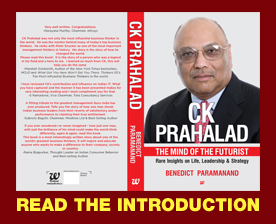By Benedict Paramanand
With global business houses like Unilever, Renault, Philips and Cisco joining the Ellen MacArthur Foundation the idea of Circular Economy has gained critical momentum. The ‘take-make-dispose’ model is slowly but surely making way for ‘made-to-be-madeagain’ model. Businesses are expecting to reap huge gains by driving costs down.
Mining companies no longer want to sell minerals to producers. Instead, they want to lease it to them. Washing machine companies want to lease machines to communities and not sell single pieces to consumers. Cars and scooters are being designed in such a way that most of the parts can last a life time and more.
Welcome to the ‘Circular Economy’ model that could soon replace the ‘take-make-dispose’ model. A good beginning is being made with the World Economic Forum taking it up this year. The serious talk is about why it is inevitable to shift from a throughput and linear manufacturing model to a restorative model where almost nothing goes waste. This model is the ultimate form of biomimicry – nothing that Nature produces goes waste.
This is not some fashionable concept touted by nerdy economists any more. Already, Unilever, Cisco, Kingfisher, Philips and Renault have joined Ellen MacArthur Foundation (education) which is promoting the circular economy model globally. This group represents key industry players working to pilot and test circular economy practices at scale. Their industry expertise reach across information technology, retail, healthcare, consumer lifestyle, lighting, automotive and FMCG.
The circular economy is enabled by disruptive information technology and the design of materials and products to flow in effective cycles and at high quality – ‘made to be made again’. It promises billions of dollars of materials cost savings every year.
Conditions are ripe today for the circular economy model to spread widely and quickly – upward trending and volatile materials and energy prices, difficult credit conditions are going to be the key value driver for the coming decades. A recent book titled ‘A New Dynamic: Effective Business in a Circular Economy’ features leading thinkers and practitioners in the field. It offers a comprehensive overview of the model, business case studies, the performance economy, history and the entrepreneurial opportunities.
Why Circular Economy
Paul Polman, CEO of Unilever, the newest member to join the Ellen MacArthur foundation said: “The concept of a circular economy promises a way out. Here products do not quickly become waste, but are reused to extract their maximum value before safely and productively returning to the biosphere. Most importantly for business leaders, such an economy can deliver growth. Innovative product designers and business leaders are already venturing into this space.”
Ken Webster, an expert in Circuler Economy told SustainabilityNext in an interview that resource companies such as mining, steel, metals are realizing that they are losing their precious molecule even as prices are going up. “The old saying was – today’s products are tomorrow’s resources at yesterday’s prices. For 100 years price of metals has been falling and it was silly to keep it. Now the challenge is, it’s going to be more expensive and so they are exploring different business models.” Webster is head of learning at Ellen foundation and is that author of the influential book ‘Sense and Sustainability: Educating for a Low Carbon World’
Unilever believes it has the potential to pilot circularity across global fast-moving supply chains, and with two billion consumers worldwide using a Unilever product each day, the opportunity to test it at scale is clear. The foundation outlined a $ $700 billion opportunity for the FMCG sector in its second economic report in 2013.
The authors note: “The consumer goods industry is starting to embrace the potential of the circular model. For durables, the benefits of reuse have been more widely demonstrated. For consumer goods – such as food and beverages or apparel and their packaging – which are short-lived and often transformed during use, the economic benefits of a circular design seem initially harder to capture. Yet recovering part of the US $2.6 trillion of material value lost each year is a huge opportunity for fast-moving consumer goods companies and Unilever will prove to be an important pathfinder within the industry.”











Recent Comments